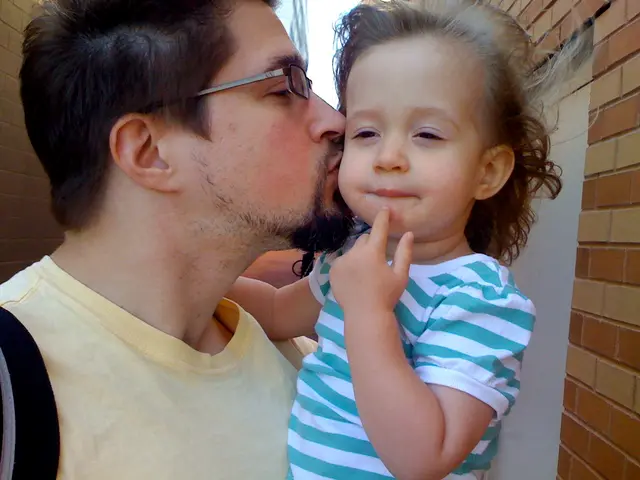Timeline for Recovery and Aftercare Following Caesarean Section Delivery
C-Section Recovery: What to Expect and How to Bounce Back
Having a baby is a significant life event, and while it can be an exciting time, it can also take a toll on your body, especially after a C-section. Check out this guide on recovering from a C-section and what to expect during those crucial six weeks.
As a C-section accounts for 31.7% of all deliveries in the U.S., it's essential to understand what goes into the recovery process, what to avoid and how to ensure a smooth healing process.
Ob/Gyn Erin Higgins, MD, walks us through a typical C-section recovery timeline and the best practices for speeding up recovery.
How long does it take to recover from a C-section?
Typically, it takes about six weeks to recover from a C-section, but each woman's timeline will be different. Recovery requires patience and gentle care, as an incision made in your lower abdomen must heal.
During the recovery period, it's important to avoid lifting anything heavier than your baby, abstain from sex, and refrain from rigorous exercise. Your doctor may recommend a C-section if you've had one in the past, if your baby is in distress, if there's a breech position, if labor isn't progressing, or if you're giving birth to multiple children at once.
Recovery Timeline
While most women recover in about six weeks, it's important to remember that each recovery journey is unique. Here's what to expect:
Week 1:
Most women spend two to four days in the hospital after a C-section. During this time, hospital staff helps with pain management, ensures you're eating and drinking enough, and helps you move around.
Once you return home, it's crucial to take it easy and avoid activities that put pressure on the incision, such as lifting, twisting, or strenuous movements. Make sure to keep the incision clean and dry, take acetaminophen or ibuprofen on a regular schedule, and use an abdominal binder for additional support.
It's normal to have vaginal bleeding after a C-section, usually lasting four to six weeks postpartum. Generally, the first few days are the heaviest, with the passing of blood clots up to the size of a golf ball. If you're soaking one pad per hour or passing large clots, contact your doctor.
Having a support system, such as your partner, family members, or friends, is key during your recovery. To help with tasks like planning, making meals, doing laundry, and caring for your baby, is invaluable. Remember to get up and move around to avoid blood clots and bond with your newborn during this time.
Weeks 2 through 5:
By the second week, you should have your first postpartum visit. During this visit, your doctor will inspect the incision site and check on your recovery progress. Dr. Higgins recommends reaching out to your doctor if you experience excessive pain, infection at the incision site, abnormal discharge, heavy bleeding, chest pain, shortness of breath, fever, or pain or swelling in your legs.
Over the next several weeks, you may also experience "baby blues," caused by short-term fluctuations in hormones that can affect your mood. This is typical, but if you experience feelings of being depressed or hopeless, talk to your doctor about postpartum depression.
Week 6:
At this point, you should have your final postpartum appointment with your doctor. If your pain has decreased, and the incision is properly healing, you may be given the green light to resume normal daily life. Remember that recovery timelines vary for each woman, so listen to your body and consult with your doctor if you need more time.
Tips for Recovery
Caring for a newborn while recovering from surgery may not leave much time for self-care, but it's crucial to take time to care for yourself. Here are some tips to help you stay on track:
- Rest and Relaxation: Your body needs time to heal, so try to rest whenever possible.
- Physical Therapy: Physical therapy exercises can help improve pelvic floor muscle tone and strengthen core muscles, ultimately speeding up recovery.
- Stay Hydrated and Eat Right: Maintaining a healthy diet rich in nutrients and staying well-hydrated supports your overall health and healing.
- Monitor Your Pain: Use a heating pad to provide relief, and follow any instructions from your doctor regarding pain medication.
- Avoid Heavy Lifting: Refrain from lifting anything heavier than your baby for several weeks.
- Taking Walks: Gentle walks help improve circulation and reduce the risk of blood clots.
By taking steps to care for yourself, staying patient, and following your doctor's guidance, you'll soon be on the road to recovery. Once you've had time to heal, you'll be able to enjoy your new bundles of joy and get back to normal life.
- Proper nutrition and hydration play a vital role in promoting overall health and healing during C-section recovery, making a well-balanced diet and staying hydrated essential components of your health-and-wellness routine.
- As you progress through your C-section recovery, it's essential to include health-and-wellness practices such as gentle exercise, physical therapy, and stress management techniques to promote a smoother healing process and maintain womens-health.
- By following the recommended best practices from your Ob/Gyn, most parents will be able to smoothly transition into parenting life and effectively manage the responsibilities involved during C-section recovery, ensuring the best possible health outcomes for both mother and child.








